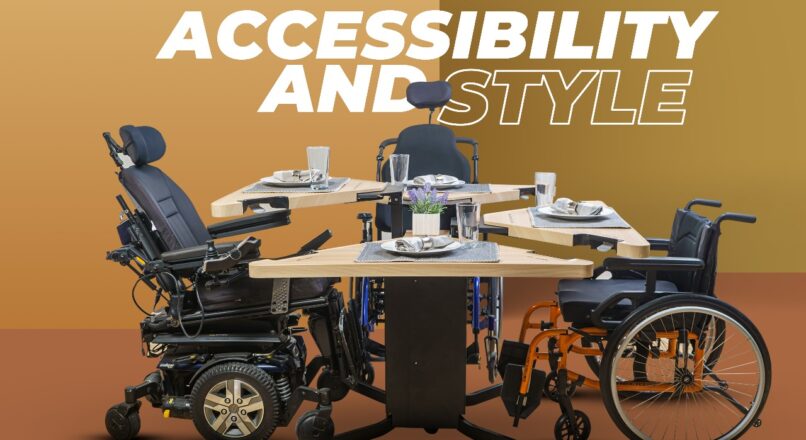
The Role of Adjustable Inclusion Table in Disability Empowerment
The Role of Adjustable Inclusion Table in Disability Empowerment
In the journey towards a more inclusive and accessible world, the movement toward inclusivity and accessibility has gained significant momentum in recent years, and for good reason. It is high time that designing spaces to accommodate persons with disabilities is no more an afterthought but a priority. Among the many adaptive innovations, an adjustable Inclusion Table stands tall for being among those that provide people with disabilities flexibility, independence, and a more accessible world. These tables are much more than furniture pieces; they symbolize freedom and equality to those who work on them. This blog will investigate the role that adjustable inclusion tables play in the context of disability empowerment and why they form an important basis in the quest for accessible and inclusive spaces.
Accommodation for disability describes provisions and adaptations that a person with a disability needs to access or participate in something. It will contribute to removing obstacles and promoting equality and inclusion. Proper granting of disability accommodations enables people with disabilities to participate in society as contributors and provides them with full opportunities to excel alongside others.
The Role of Adjustable Inclusion Table
Enhancing Accessibility and Independence
Equally appealing about adjustable Inclusion tables is the fact that it tears down physical barriers. Due to their fixed heights, standard tables do little in considering users in wheelchairs or those with some other kind of mobility-related impairments. The advantage with adjustable Inclusion tables is that they allow the users to adjust the height according to their needs; this ensures that persons of all abilities shall be able to use and access the table without much hassle and do so comfortably. The adjustability of the table enables wheelchair users to bring the table to an appropriate height at which they could be independent at the table, doing various activities such as writing, eating, or working.
Reducing Physical Strain and Improving Ergonomics
Physical strain is a common challenge for people with disabilities when using traditional furniture. Tables with fixed working surfaces that do not consider individual variations in body type and alternative use patterns will make the person stay in a limited or distorted way, with back pain and neck strain being part of other long-term physical problems. Adjustable Inclusion tables provide ergonomic solutions, on the other hand, which decrease discomfort. These are tables that can be adjusted to the user’s specific needs, thus enabling one to maintain proper posture. This reduces the level of strain the person may undergo
Promoting Independence
For individuals with disabilities, maintaining independence is often a top priority. Adjustable tables are just one important tool to further that independence because it grants the users self-sufficiency in adjusting the environment around them without requiring any help from anyone. A person who doesn’t have much strength in his or her upper body or who has limited mobility may find it difficult to use a table of fixed height. Therefore, an adjustable table would mean setting a perfect height and angle to avoid strain that may make daily activities easier.
Assistive Technologies for Accessibility Adjustable table for disability
Technology ensures a level playing field of experiences and opportunities for persons with disabilities in today’s digital era. This revolution very powerfully empowers people with disabilities in reaching out to the world on equal terms, tearing down the barriers, and facilitating equal opportunities for people with disabilities. Adaptive devices, software, screen readers, and magnifiers are some of the tools that enable and facilitate individuals in accessing the digital environment easily.
Why the Inclusion Table Matters:
Inclusion Table is specially designed to have more space for people in wheelchairs comfortably. It offers more clearance under the table and a more open design so wheelchair users can easily pull right up to the table without needing to shift or move other chairs around. This will ensure that wheelchair users can enjoy a meal or conversation just like all the rest of your guests.
The Inclusion Table® offers a unique setting where multiple wheelchairs can be at the same table and offers features like:
Height adjustability: The Inclusion Table® can be adjusted to the height of the wheelchair, ensuring comfortable and ergonomic use
Accessibility features: The Inclusion Table® includes features an open bottom, allowing for easy wheelchair access, or a tilting top for improved visibility and reachability.
Durability and stability: The Inclusion Table® should be designed to be durable and stable, to prevent tipping or wobbling
Conclusion
Adjustable Inclusion tables play a crucial role in empowering individuals with disabilities by enhancing accessibility, promoting independence, and fostering social inclusion. We take further steps toward making our spaces friendly and accessible for all by buying adaptive solutions, and therefore enable people with disabilities to live their lives in a much more independent and self-fulfilling way for people with disabilities to thrive. Embracing these adaptive pieces of furniture means we are one step closer toward making the world inclusive, a world of full participation and equality for all, regardless of ability.
We’d love to hear from you! Whether you have questions, need support, or want to learn more about how adjustable Inclusion tables can empower accessibility and inclusion, reach out to us.

Leave a reply